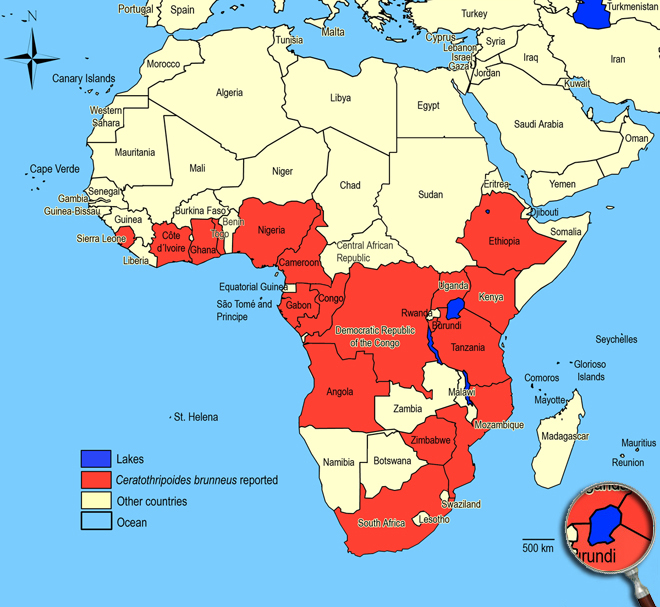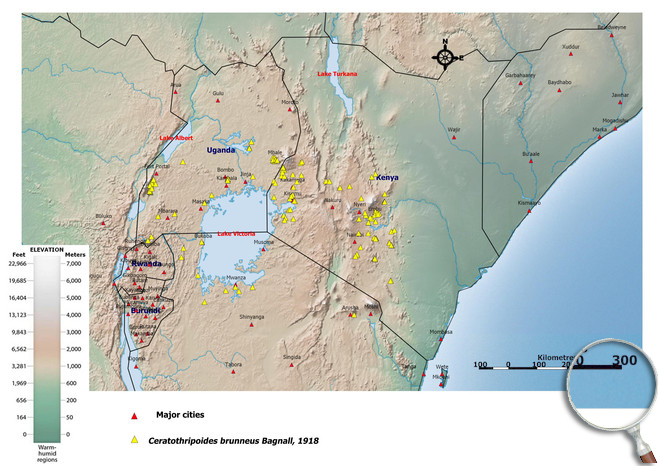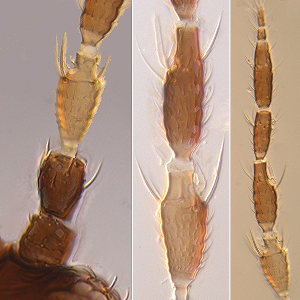Ceratothripoides brunneus Bagnall, 1918
Thripinae, Thripidae, Terebrantia, Thysanoptera
Figures
Fig. 1: 8-segmented antenna, scape, pedicel and segment III, segments III and IV with forked sense cone, segments III-VIII
Fig. 2: Head dorsal with ocellar triangle
Fig. 3: Pronotum
Fig. 4: Meso- and metanotum
Fig. 5: Meso- and metasternum
Fig. 6: Fore- hind wing, fore wing distal region
Fig. 7: Fore wing clavus
Fig. 8: Tergites V-VII
Fig. 9: Tergites VIII with posteromarginal comb and tergite IX
Fig. 10: Sternites VI and VII
Fig. 11: Sternites V-VII with sternal pore plates, male
Fig. 12: Posteromarginal comb of tergite VIII and tergites IX-XI, male
Fig. 13: Adult female on a leaf
Introduction and recognition
Ceratothripoides brunneus is a wide spread pest of solanaceous crops like tomato, eggplant, capsicum, chillies, African nightshade, African eggplant and potato. Both sexes fully winged. Body brown; all tarsi, apices of tibiae and antennal segment III yellow, IV-V variably yellow and brown; fore wings brown or deeply shaded. Antennae 8-segmented; segments III & IV with forked sense cone and many microtrichia, segment I with pair of dorso-apical setae (Fig. 1). Head with 3 pairs of ocellar setae, pair III very long and arising within ocellar triangle; compound eyes with no pigmented facets (Fig. 2). Pronotum with 2 pairs of elongate posteroangular setae (Fig. 3). Mesonotum without campaniform sensilla; mesosternal furca with spinula (Fig. 5). Metanotum sculptured lines transverse at anterior and irregular equiangularly at posterior; median setae longer than lateral setae and arising at anterior margin; campaniform sensilla absent (Fig. 4). Mid and hind tarsi 2-segmented. Fore wing first vein with about 7 setae basally and 2 setae distally; second vein with complete setal row; fore wing clavus with 6 or 7 marginal setae but no discal seta (Fig. 6 and 7). Tergites without ctenidia; tergite VIII posterior margin with complete comb of long and slender microtrichia (Fig. 8 and 9); X with dorsal split. Sternites III-VI with 3 pairs of marginal setae; marginal setae as long as sternites; VII with S1 and S2 arising well in front of posterior margin (Fig. 10).
Male sternites III-VII with 2 or more irregular transverse rows of small glandular areas (Fig. 11); tergite IX with median setae slender (Fig. 12).
Taxonomic identity
Species
Ceratothripoides brunneus Bagnall, 1918
Taxonomic history
Taeniothrips brunneus Mound, 1968
Physothrips marshalli Bagnall, 1918
Taeniothrips ventralis Priesner, 1952
Physothrips ventralis Hood, 1918
Common name
-
Present taxonomic position
Family: Thripidae Stephens, 1829
Subfamily: Thripinae (Stephens) Karny, 1921
Genus: Ceratothripoides Bagnall, 1918
Genus description
The genus Ceratothripoides Bagnall, 1918
This genus comprises 5 Old World species from the Africa and the Oriental region. One of these species, Ceratothripoides claratris, is recorded as a tospovirus vector on tomatoes with different levels of virulence (Premachandra et al. 2005; Halaweh & Poehling 2009). Species of Ceratothripoides have following characters: 8-segmented antennae, antennal segments III & IV with forked sense cone, antennal segment I with a pair of small dorso-apical setae, tergite VIII posterior margin with complete comb of long microtrichia, sternites III-VI with 3 pairs of marginal setae, and sternite VII with S1 and S2 arising well in front of posterior margin (Mound & Nickle 2009). All of them have a wide gap in the setal row on the first vein of fore wing, and a complete setal row on the second vein. In some cases, like Ceratothripoides claratris and Ceratothripoides cameroni discrimination is difficult and not always clear.
Species description
Typical key character states of Ceratothripoides brunneus
Coloration and body sculpture
Body color: mainly brown to dark brown
Surface of head, pronotum and fore legs: without obvious or with weakly reticulate sculpture
Antennae
Form of sense cones on antennal segments III and IV: emergent and forked on segments III and IV
Number of antennal segments: 8
Antennal segment I: with pair of small setae on dorso-apical margin
Antennal segment II: without an exceptionally long seta at the inner apex
Antennal segment II shape: symmetric
Antennal segment III shape: symmetric
Antennal segment IV and V: without a hyaline ring at the base
Antennal segment VI bears: not a remarkably dagger-shaped sensorium
Forked sense cone on antennal segment IV: scarcely extending beyond base of segment V
Length of antennal segment III and IV: antennal segment III similar in length to segment IV
Head
Distance between bases of ocellar setae III: greater than width of first ocellus (rare: same or less than width of first ocellus)
Head: not prolonged in front of compound eyes
Ocellar setae I: present (mostly one behind the other)
Length of ocellar setae II: shorter than setae III
Ocellar setae III: arising within ocellar triangle anterior to tangent of anterior margin of hind ocelli
Ocelli: present
Length of postocular setae: not alternating short and long setae
Number of ocellar setae: 3
Compound eyes: without pigmented facets
Prothorax
Number of pairs of long anteroangular setae: 0
Number of pairs of long posteroangular setae: 2
Number of pairs of elongate pronotal setae: 2
Number of pairs of posteromarginal minor setae: 3-4
Pronotal blotch or internal apodeme: absent
Pronotum shape: broadly rectangular
Pronotum posteromarginal/posteroangular setae: S2 longer than S3, not equal in length
Mesothorax
Campaniform sensilla: absent
Mesosternal furca: with median spinula
Metathorax
Metanotal campaniform sensilla: absent
Metanotal median setae: S1 at anterior margin
Metanotum with dominant sculptured triangle medially: absent
Metasternal furca: without spinula
Sculpture of metanotum median area: transverse at anterior, but irregular longitudinal or equiangular reticulations on posterior half
Shape of metathoracic furca: transverse, V-shaped
Metanotal median setae length: longer than lateral metanotal setae
Wings
Fore and hind wings: present, more than half as long as abdomen (macropterous)
Fringe cilia arising: from sockets
Fore wing veins: present
Fore- and hind wing surface: covered with microtrichia
Apex of fore wing: with prominent terminal setae
Fore wing anterior margin (costal vein): with setae and cilia but cilia longer than setae
Fore wing clavus - number of discal setae: 0
Fore wing clavus - number of marginal setae: 6-7
Fore wing costal fringe cilia: arising at anterior margin of wing
Fore wing first vein: distinct from costal vein
Fore wing first vein setal row: incomplete, with setae not closely and uniformly spaced
Fore wing second vein setal row: complete, setae uniformly spaced
Fore wing shape: mainly parallel sided or margins run continuously towards each other
Fore wing surface: not reticulate
Fore wing first vein number of setae on distal half: 2
Fringe cilia on posterior margin near apex: distinctly wavy (undulated)
Length of fore wing costal setae at middle of wing: longer than half of median wing width
Fore wing extreme apex color: dark
Fore wings: uniformly dark brown or uniformly dark or shaded, but with base or sub-base pale, (rare: entirely brown, sometimes with slightly paler areas subapically, medially and sub-basally or uniformly light brown)
Legs
Fore tibia: not prolonged around fore tarsus
Mid and hind tarsi: with two segments
Color of fore tarsi: pale or yellow, sometimes apical shaded or brown
Abdomen
Pleurotergites: not covered in microtrichia
Sternite II: with marginal setae but no discal setae
Sternites IV, V and VI: with marginal setae but no discal setae
Sternite VII median posteromarginal setae S1: arising in front of posterior margin
Sternite VII: with marginal setae but no discal setae
Surface of lateral thirds of abdominal tergites: without regular rows of fine microtrichia
Tergites II to VII median setal pair: no more than 0.3 as long as median length of tergite
Tergites IV and V median setal pair: shorter than distance between their bases
Craspedum on tergites IV to VI: absent
Tergites V to VII: without ctenidia laterally, but sometimes with rows of microtrichia
Tergite VIII ctenidia: without paired ctenidia laterally, sometimes with irregular microtrichia
Tergite VIII posteromarginal comb of microtrichia: present and complete medially
Tergite VIII shape of posteromarginal microtrichia: long, slender and regular or irregular
Tergite X: not tubular, longitudinally incomplete
Setae on abdominal tergite X: all setae slender

Similar or related species
Ceratothripoides brunneus is very similar to Ceratothripoides revelatus. Compared to other species of that genus from Africa, both species have brown or deeply shaded fore wings and compound eyes without pigmented facets (Ceratothripoides cameroni and Ceratothripoides claratris have uniformly pale fore wings and compound eyes with 4 to 5 weakly pigmented facets). Furthermore, in Ceratothripoides cameroni and Ceratothripoides claratris ocellar setae III arising always on anterior margin of ocellar triangle, and the distance between bases of ocellar setae III is always greater than width of first ocellus (in Ceratothripoides revelatus always less than width of first ocellus; in Ceratothripoides brunneus less, same or greater than width of first ocellus; both with ocellar setae III arising within ocellar triangle). Ceratothripoides brunneus differs from Ceratothripoides revelatus in having the metanotal sculptured lines transverse at anterior and irregular equiangular reticulations on posterior half, meso- and metanotum without campaniform sensilla, and the fore wing clavus with 6 or 7 marginal setae but no discal seta. Ceratothripoides revelatus has a metanotal median area mainly with equiangular reticulation, meso- and metanotum with campaniform sensilla, and the fore wing clavus with 5 or 6 marginal setae and 1 discal seta. The other two species (Ceratothripoides cameroni and Ceratothripoides claratris) exhibit the following characteristics: meso- and metanotum without campaniform sensilla, fore wing clavus with 5 or 6 marginal setae and no discal seta.
Species of Ceratothripoides are similar to species of Craspedothrips, Diarthrothrips coffeae, Lefroyothrips pictus, Megalurothrips sjostedti and Tenothrips frici in having 8-segmented antennae with forked sense cone on segments III and IV and 2 pairs of elongate pronotal setae posteroangularly, in lacking ctenidia laterally on tergites V-VIII and regular rows of fine microtrichia on lateral thirds of tergites. Species of Ceratothripoides as well as Lefroyothrips pictus differ from other species by the complete posteromarginal comb of slender microtrichia on tergite VIII, whereas other species have a continuous craspedum (Craspedothrips hargreavesi), no comb of microtrichia (Craspedothrips xanthocerus, Diarthrothrips coffeae) or a comb of short microtrichia only laterally on posterior margin of tergite VIII (Megalurothrips sjostedti and Tenothrips frici). Compared to Lefroyothrips pictus with distinctly bicolored body color, antennal segment I without any setae on dorso-apical margin, metanotal median area scarcely sculptured on posterior half, and median pair of marginal setae on sternite VII arising at margin, species of Ceratothripoides with usually uniformly brown body color, antennal segment I with a pair of small setae on dorso-apical margin, metanotal median area always sculptured with equiangular reticulations on posterior half, and median posteromarginal setae on sternite VII arise always in front of margin. Furthermore, species of Ceratothripoides have the fore wings usually uniformly brown or uniformly pale or yellow, compared to Lefroyothrips pictus with banded fore wings.
Biology
Life history
As with other thrips species the life cycle from egg to adult is dependent on temperature. The full cycle can take less than a week to over a month and adults may live for more than one month producing several generations in one year depending on seasonal weather (Lewis 1973).
Host plants
Particularly on solanaceous crops, also other cultivated crops.
Crops: African eggplant, African nightshade, amaranthus, banana, beans (cowpea, deer-eye beans (Mucuna sp.), French bean), capsicum, carrot, chillies, cocoa, coffee, cotton, citrus, eggplant, hibiscus, karela, kola nut, melon, orchid, papaya, passion fruit, potato, pumpkin, sweet pea, sweat, tea, tomato, watermelon.
Weeds: Ageratum conyzoides, Bidens pilosa, Galinsoga parviflora, Solanum incanum, Sonchus oleracea, Tithonia diversifolia.
Vector capacity
None identified, but possible mechanical distribution of phytopathogenic fungi and bacteria.
Damage and symptoms
Damage symptoms include silvering of the abaxial leaf surface and the leaves crinkle. Malformed fruits with brown rusty lesions are also observed on the fruits.
Detection and control strategies
Ceratothripoides brunneus occurs as the major thrips species infesting tomato and other solanaceae crops grown in the low and mid-altitude regions. However this species is not observed in very high altitude regions beyond 2000 msl. In the high altitude region, Ceratothripoides brunneus is replaced by Western Flower Thrips in Kenya. They are naturally parasitized by Ceranisus menes. Ceratothripoides brunneus is also highly attracted to blue coloured sticky traps as compared to yellow and they are influenced by the kairomonal thrips attractants based on floral volatile signals.
Additional notes
Breeds mostly on the leaves
Biogeography
Africa, Puerto Rico, Malaysia, Netherlands (greenhouse), Australia. Angola, Burundi, Cameroon, Congo (Rutshuru, Bumba, Mahagi), Ethiopia, Gabon, Ghana (Aburi), Ivory Coast, Kenya, Mozambique, Nigeria (Ibadan), Sierra Leone, South Africa (KwaZulu-Natal), Togo, Kenya, Tanzania, Uganda.
African countries where Ceratothripoides brunneus has been reported

Occurence of Ceratothripoides brunneus in East Africa

Please click here for survey sites of all observed thrips species of Kenya, Tanzania and Uganda.
Click here for locations of Ceratothripoides brunneus in parts of East Africa.

Bibliography
Bagnall RS (1918). Brief descriptions of new Thysanoptera - IX. Annals and Magazine of Natural History, Zoology, Botany and Geology. (Serie 9) 1: 201-221
Bagnall RS (1918). On the rubber thrips (Physothrips funtumiae Bagn.) and its allies. Bulletin of Entomological Research. 9: 65-70
Bhatti JS (1969). Taxonomic studies in some Thripini (Thysanotera: Thripidae). Oriental Insects. 3 (4): 373-382
Bournier J-P (2002). Les thysanoptères du cotonnier. Les dé prédateurs du cotonnier en Afrique tropicale et dans le reste du monde, No. 12. CIRAD-CA, Montpellier, 104 pp
Faure JC (1962). Thysanoptera of Africa - 8. Revue de Zoologie et de Botanique Africaines. 66 (1-2): 165-183
Halaweh N & Poehling H-M (2009). Inheritance of vector competence by the thrips Ceratothripoides claratris (Shumsher) (Thysanoptera: Thripidae). Journal of Applied Entomology 133: 386-393
Hood JD (1918). A new Physothrips from western Africa (Thysanoptera). Insecutor Inscitiae Menstruus. 6 (4-6): 116
Lewis T (1973). Thrips: their biology, ecology and economic importance. Academic Press Inc., London Ltd., 349 pp.
Moritz G (2006). Thripse. Pflanzensaftsaugende Insekten, Bd. 1, (1. Auflage). Westarp, Hohenwarsleben, 384 pp. ISBN-13: 978-3-89432-891-7
Moritz G, Morris DC & Mound LA (2001). ThripsID - Pest thrips of the world. ACIAR and CSIRO Publishing Collingwood, Victoria, Australia, CDROM ISBN 1 86320 296 X
Moritz G, Mound LA, Morris DC & Goldarazena A (2004). Pest thrips of the world - an identification and information system using molecular and microscopical methods. Centre for Biological Information Technology, University of Queensland, Australia, CDROM ISBN 1 86499 781 8
Mound LA (1968). A review of R. S. Bagnalľs Thysanoptera collections. Bulletin of the British Museum (Natural History), Entomology. Supplement 11: 1-181
Mound LA & Nickle DA (2009). The Old-World genus Ceratothripoides (Thysanoptera: Thripidae) with a new genus for related New-World species. Zootaxa. 2230: 57-63
Nickle DA (2009). Commonly intercepted thrips at U.S. ports-of-entry from Africa, Europe, and the Mediterranean. IV. Miscellaneous thripine genera excluding Frankliniella, Iridothrips, and Thrips (Thysanoptera: Thripidae). Proceedings of the Entomological Society of Washington. 111 (1): 215-238
Pitkin BR & Mound LA (1973). A catalogue of West African Thysanoptera. Bulletin de ľInstitut Fondamental ďAfrique Noire, Série A. 35 (2): 407-449
Premachandra DWTS,
Borgemeister C,
Maiss E,
Knierim D &
Poehling H-M (2005). Ceratothripoides claratris, a new vector of a Capsicum chlorosis virus isolate infecting tomatoes in Thailand. Phytopathology 95 (6): 659-663
Priesner H (1952). On some Central African Thysanoptera. Bulletin de ľInstitut Fondamental de ľAfrique Noire. 14 (3): 842-880
----
Web links
Mound´s Thysanoptera pages
Thysanoptera Checklist
ICIPE Thrips survey sites
UNI Halle & Thrips sites
Thrips of California
















